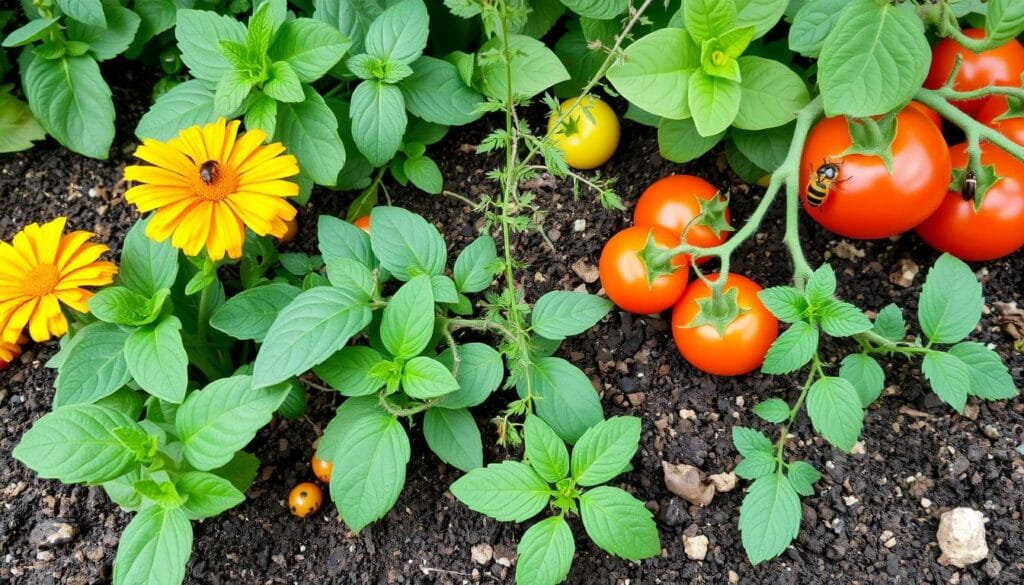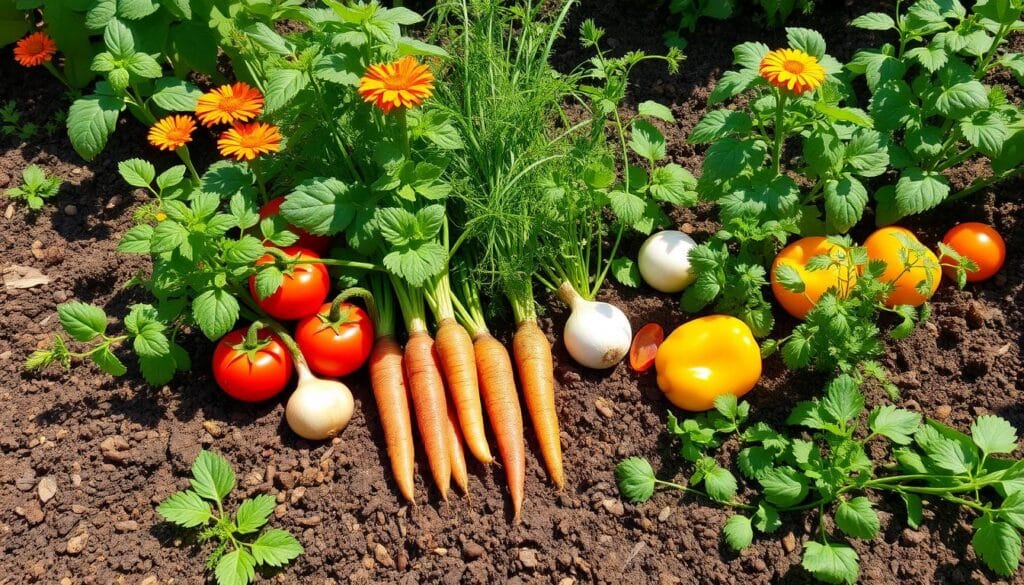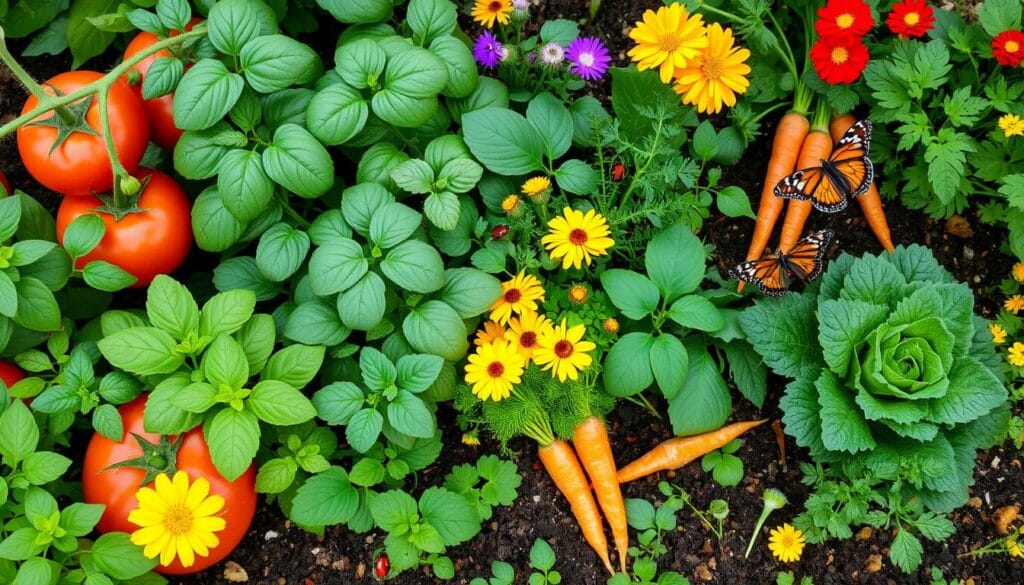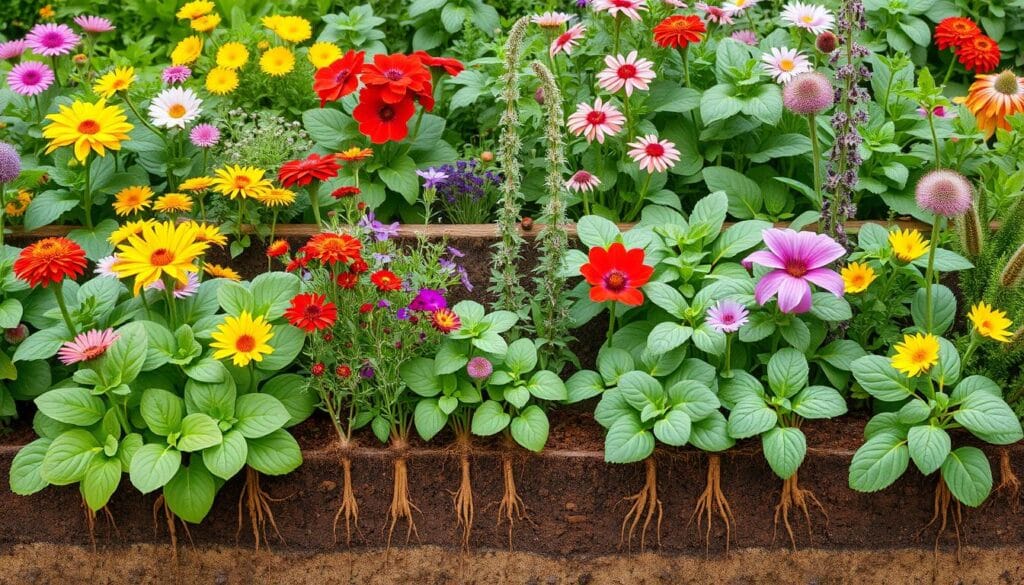When you garden, you might have seen how companion planting works. It’s about growing different plants together to make them healthier and more productive. This method helps control pests and diseases naturally and improves soil health. By pairing plants, you create a balanced garden that grows well without needing many chemicals.
In Florida, where the climate and pests are unique, companion planting is very useful. For instance, marigolds near tomatoes can keep nematodes and aphids away. Basil, on the other hand, makes tomatoes taste better and keeps mosquitoes and flies off. Using companion planting can cut down pesticide use by up to 75% in vegetable gardens.
Companion planting helps reduce pests, improves soil, and boosts crop yields. It can also cut down weed growth by 30% and increase garden diversity by 40%. This approach makes your garden healthier and plants stronger.
Key Takeaways
- Companion planting can reduce pests by attracting beneficial insects, repelling pests, and acting as trap crops.
- Companion planting can increase crop productivity by up to 20% through improved pollination and pest control.
- Companion planting can lead to a 30% reduction in weed growth and increase overall biodiversity in gardens by up to 40%.
- Companion planting can reduce water consumption in gardens by up to 50% through improved soil structure and water retention capabilities.
- Companion planting can enhance soil structure by up to 25% and increase nutrient absorption by plants by 10%.
What is Companion Planting?
Companion planting is a way to grow different plants together to make them healthier and more productive. It’s been around for centuries, aiming to create a balanced garden ecosystem. By learning about companion planting, you can make your garden better at fighting pests and diseases.
A companion planting guide is a great starting point. It tells you which plants go well together and how to make a harmonious garden. A companion planting chart is also helpful, showing you the best plant combinations and their benefits.
Definition and Basics
Companion planting works because different plants have different needs and ways of growing. By planting them together, you make your garden more diverse and strong. For instance, some plants can shade others, while others attract good bugs or keep pests away.
Historical Significance
For centuries, gardeners have used companion planting. It started with indigenous cultures, who noticed how plants interacted and used this to grow great gardens. Now, it’s seen as a key way to grow sustainable and productive gardens.
Common Practices
Some common practices include growing marigolds with tomatoes to fight nematodes and basil with tomatoes to enhance flavor. Other examples are growing beans with corn and squash for a balanced garden, and nasturtiums with cabbage to keep aphids away.
By using a companion planting guide and a companion planting chart, you can build a thriving garden. Choose plants that like similar conditions and have enough space. Also, watch how plants interact to create a peaceful garden.
| Plant | Companion Plant | Benefit |
|---|---|---|
| Tomatoes | Basil | Improves flavor |
| Cabbage | Nasturtiums | Repels aphids |
| Beans | Corn and squash | Creates a balanced ecosystem |
How Companion Planting Enhances Pest Control
Companion planting for pest control has been around for centuries. It helps gardens grow healthier without pesticides. By picking the right plants to grow together, you can make your garden better.
One great thing about companion planting is it attracts good bugs. For example, basil keeps aphids away from veggies. Marigolds also help by fighting off nematodes and whiteflies.
Natural Pest Deterrents
Some plants are better at keeping pests away than others. Plants like chives, onions, and garlic from the allium family are good at this. They smell bad to pests like Japanese beetles and aphids.
The Role of Attractant Plants
Attractant plants are key in fighting pests. They draw in good bugs that eat pests. For example, nasturtiums lure pests away from important plants and look nice too.
Examples of Effective Combinations
Here are some good pairs for fighting pests:
- Tomatoes and basil: Basil keeps pests off tomatoes and makes them taste better.
- Marigolds and carrots: Marigolds keep nematodes and other pests away from carrots.
- Radishes and cucumbers: Radishes keep cucumber beetles and other pests off cucumbers.

Improving Soil Health Through Companion Planting
Companion planting is a way to grow different plants together to make the soil healthier. By picking the right plants, you can create a balanced ecosystem. For instance, growing legumes with grains can fix nitrogen in the soil. Also, planting comfrey with vegetables can act as a natural fertilizer.
One big advantage of companion planting is how plants share nutrients. By growing plants that need different nutrients, you can make the soil healthier. Companion planting herbs like basil and rosemary can also keep pests away and improve soil health.
Nutrient Sharing Between Plants
Nutrient sharing is a key part of companion planting. By planting different species together, you can make a system where plants with different needs can thrive. For example, growing shallow-rooted plants like broccoli with deep-rooted plants like melons can make nutrient uptake more efficient.
The Impact on Soil Microorganisms
Companion planting also helps soil microorganisms. By creating a diverse ecosystem, you can encourage beneficial microorganisms to grow. These microorganisms help break down organic matter and recycle nutrients, making the soil more fertile.
Some good examples of companion planting for better soil health include growing pole beans, corn, and winter squash together. Or, planting cabbages with aromatic herbs like basil and rosemary. These combinations help share nutrients, improve soil structure, and reduce the need for fertilizers and pesticides.
Popular Companion Planting Combinations
Companion planting is all about creating a balanced garden. It pairs vegetables, flowers, and fruits to boost growth. For instance, the “three sisters” method pairs corn, beans, and squash. The corn supports the beans and squash, while beans enrich the soil.
Tomatoes and basil or marigolds make a great pair. They repel pests and enhance flavor. Companion-planting flowers like nasturtiums and calendula attract pollinators and fight aphids. Strawberries paired with borage improve in taste and growth.

- Marigolds with kale to reduce aphids
- Basil with tomatoes to repel flies and mosquitoes
- Beans with corn and squash to create a balanced ecosystem
- Nasturtiums with cucumbers to repel aphids and beetles
Using these combinations in your garden can make it diverse and healthy. It also cuts down on pesticide use.
Understanding Plant Companionship
Exploring companion planting reveals the intricate relationships between plants. A good companion planting guide helps create a balanced garden. This balance promotes healthy growth and cuts down on pesticide use. By picking the right plants, your garden can grow up to 30% more and attract more pollinators.
A companion planting chart is a great tool for garden planning. It shows which plants benefit from each other, like tomatoes and basil. It also tells you which plants should stay apart. For instance, onions, sage, and oregano can keep pests away. Beans and legumes add nitrogen to the soil, benefiting other plants.
When making a companion planting guide, remember a few key points:
- Plant crops with similar water and soil needs together
- Use trap cropping to reduce pesticide use
- Pair plants that attract beneficial insects, like ladybugs and lacewings
- Avoid planting crops that are easily affected by the same diseases
By following these tips and using a chart, you can build a thriving garden. Make sure to pick plants that fit your climate and soil. Don’t hesitate to try new combinations to see what works best for you.

With some planning and creativity, you can make your garden healthy, productive, and stunning. Whether you’re new to gardening or have experience, a well-made companion planting guide is a valuable resource. It helps you reach your gardening goals.
| Plant | Companion Plant | Benefit |
|---|---|---|
| Tomatoes | Basil | Repels pests improves growth |
| Carrots | Onions and chives | Repels pests and improves growth |
| Beans | Corn | Provides support, fixes nitrogen |
The Science Behind Companion Planting
Research on companion planting shows that some plants can make crops grow better and fight pests and diseases. For instance, marigolds with kale can cut down aphid numbers by drawing in helpful flies and wasps. Also, growing many plants together can lower pest pressure more than growing just one type.
Some plants, like legumes, help other plants grow by adding nitrogen to the soil. The “potato onion” can keep diseases away from tomatoes. Halophytic plants, like purslane, can make strawberries grow better and taste sweeter when planted together.
Here are some good plant pairs:
- Marigolds and kale to reduce aphid populations
- Leguminous plants and non-legumes to improve growth
- Potato onions and tomatoes to inhibit soil-borne diseases
- Purslane and strawberries to improve yields and fruit quality

Learning about companion planting can make your garden more diverse and strong. It can cut down on pesticide use and help plants and soil grow well.
| Companion Plant | Benefit |
|---|---|
| Marigolds | Repels nematodes and attracts beneficial insects |
| Leguminous plants | Fixes nitrogen and improves soil health |
| Potato onions | Inhibits soil-borne diseases |
Addressing Pest Challenges with Companion Plants
Exploring gardening, you’ll find that using companion plants to fight pests is very effective. It helps keep your garden healthy and balanced. For example, radishes can keep cucumber beetles away when planted with cucumbers. Nasturtiums can also keep aphids from cabbage.
Aphids, whiteflies, and flea beetles are common pests. To fight them, use plants like marigolds and nasturtiums. Marigolds release chemicals that harm nematodes, while nasturtiums attract hoverflies that eat aphids. Other good plants include thyme, sage, and chives. They help keep pests away from blueberries and attract pollinators.
- Plant marigolds as a cover crop to release toxic biochemicals into the soil
- Use nasturtiums to attract beneficial hoverflies that prey on aphids
- Plant thyme, sage, and chives near blueberries to repel pests and attract pollinators
By using these strategies, your garden will thrive. It will grow healthy plants and use fewer pesticides.
Seasonal Considerations for Companion Planting
Exploring companion planting means looking at the seasons’ impact on your garden. A good guide helps you use the seasons to your advantage. It’s key for beginners to understand these seasonal tips.
In spring, some plants do well together. Cool-season crops like broccoli and kale keep pests away. Warm-season crops like tomatoes and peppers make your garden taste better. A guide helps you pick the right plants for each season.
Best Plants for Spring Gardening
Lettuce, spinach, and radishes are great for spring. Pair them with onions and carrots to keep pests out. A guide helps you pick the best plants for a healthy garden.
Summer Companion Tips
Summer is for plants like tomatoes, peppers, and cucumbers. Basil near tomatoes helps them grow and keeps pests away. Marigolds near cucumbers fight nematodes and pests. These tips make your garden diverse and thriving.
Think about the seasons and use a guide to tailor your garden. Whether you’re new or experienced, companion planting makes your garden better and more sustainable.
Companion Planting Techniques for Beginners
Starting your gardening journey? Simple companion planting techniques can boost your plants’ health and growth. A good companion planting guide is a great starting point. It helps you create a garden that fights off pests and diseases.
Companion planting is great for growing many plants in a small space. For instance, marigolds with tomatoes can keep nematodes away and attract good bugs. Basil with lettuce makes the lettuce taste better and feel softer.
Here’s how to begin with companion planting:
- Choose the right plants: Pick ones that go well together and help each other grow.
- Plan your garden: Use a chart to plan your garden layout and plant the best combinations.
- Start small: Begin with a few plants and grow your garden as you learn more.
Some easy combinations for beginners include:
| Plant 1 | Plant 2 | Benefits |
|---|---|---|
| Tomatoes | Basil | Improves flavor and repels pests |
| Marigolds | Carrots | Repels nematodes and attracts beneficial insects |
| Radishes | Cucumbers | Repels cucumber beetles and improves growth |
By following these steps and using a guide, you can make a diverse and healthy garden. Start small and grow your garden as you learn more.
Common Mistakes in Companion Planting
Companion planting can help your garden grow strong and healthy. But, there are mistakes to watch out for. Overcrowding and competition can hurt plant growth and attract pests. Also, planting onions near asparagus or beans can lead to poor growth because they compete for nutrients.
A companion planting guide can steer you clear of these errors. It tells you which plants go well together and which don’t. For instance, don’t pair cabbage with tomatoes. Cabbage needs a lot of nutrients, and tomatoes do too. This can weaken both plants.
Tomatoes and potatoes shouldn’t be planted together either. They belong to the same family and face the same pests and diseases. This can harm both plants.
Some other plants to keep apart include:
- Fennel and tomatoes, as fennel can slow down tomato growth
- Strawberries and brassicas, because brassicas attract pests that harm strawberries
- Tomatoes and corn, both need a lot of nutrients and can compete with each other
By avoiding these companion planting mistakes and following a companion planting guide, you can make your garden a thriving place. It will grow healthy plants and need less pesticides and chemicals.
Here is a table summarizing some of the most common companion planting mistakes to avoid:
| Plant 1 | Plant 2 | Reason to Avoid |
|---|---|---|
| Onions | Asparagus or Beans | Compete for nutrients |
| Brassicas | Nightshade vegetables | Heavy feeders, reduce nutrient availability |
| Tomatoes | Potatoes | Susceptible to same pests and diseases |
The Future of Companion Planting
As we learn more about sustainable gardening, companion planting will be key. It helps with pest control and soil health. By keeping up with trends in sustainable gardening and using community and educational resources, you can lead in this change.
New methods like trap cropping and using natural pest fighters, like marigolds and basil, will grow in popularity. These methods are good for the planet. They also help plants grow better and need less chemicals.
Whether you’re new to gardening or have been doing it for years, joining local gardening communities is important. They offer the support and knowledge you need. By using companion planting, you can create a garden that’s good for your plants and the environment.
FAQ
What is companion planting?
Companion planting is a way to grow different plants together. It helps them grow better and healthier. This method also reduces the need for harmful chemicals in gardening.
How can companion planting help control pests in my garden?
It’s a smart way to keep pests away by choosing the right plants. For instance, marigolds can keep nematodes off tomatoes. Basil does the same and makes tomatoes taste better.
How does companion planting improve soil health?
It makes the soil better by letting plants share nutrients. This supports good bacteria in the soil. It’s like a team effort for a healthy garden.
What are some popular companion planting combinations?
Some favorites include the “three sisters” (corn, beans, and squash). Tomatoes and basil or marigolds are also great together. Radishes and cucumbers are another good pair.
What is the difference between symbiotic relationships and allelopathy in companion planting?
Symbiotic relationships help plants grow well together. Allelopathy, on the other hand, can harm some plants. It’s important to know the difference.
How can I identify and address common garden pests through companion planting?
Knowing which plants fight pests can help your garden. Radishes with cucumbers repel beetles. Nasturtiums keep aphids away from cabbage.
How can I adapt companion planting to different seasons and climates?
You can adjust it for any season or climate. Cool-season crops like broccoli in spring repel pests. Tomatoes and peppers in summer improve flavor.
What are some common mistakes to avoid when starting with companion planting?
Don’t overcrowd your garden. It can harm plants and attract pests. Also, understand each plant’s needs to avoid poor growth.
What is the future of companion planting?
As we focus on sustainable gardening, companion planting will grow in importance. Staying informed and using resources can help you create a pest-resistant garden.
Source Links
- Optimizing Companion Planting for Growth and Pest Control
- Best Friends Forever: What to Know About Companion Planting in Bettend
- Companion Planting Frequently Asked Questions
- Companion Planting Chart and Guide for Vegetable Gardens
- Your Guide to Companion Planting — The Purposeful You · Garden + Sustainable Living
- Companion Gardening Guide: Companion Planting for Garden Pest Control
- Companion Planting: The Ultimate Guide for Pest Control and Enhanced Pollination | EZ-FLO™ Injection Systems
- Natural Mulching Techniques for a Healthier, Greener Garden
- The Science of Companion Planting
- Benefits of Companion Planting
- The Basics of Companion Planting Garden Crops
- Companion Planting Guide: 10 Plant Pairs [2024]
- 7 Favorite Companion Planting Combinations + Why We Love Them | The Beginner’s Garden
- This Gardening Technique Keeps Pests Away Naturally
- The Benefits of Companion Planting
- All About Companion Planting
- Companion Planting: Gardening Fad or Scientifically Proven Benefits?
- Companion planting: Positive partnerships that produce more – High Plains Journal
- Boost Harvests with Companion Planting: Top Garden Pairings – Bootstrap Farmer
- The Comprehensive Guide to Companion Planting
- Early Season Veggies & Succession and Companion Planting
- The Ultimate Guide to Companion Planting for a Thriving, Sustainable G
- Companion Planting: The Ultimate Guide for a Thriving Garden
- Garden Companion Planting Chart, Plans, and Benefits
- Cultivating Harmony: A Beginner’s Guide to Companion Planting
- Vegetable Companion Planting Mistakes – 9 Disastrous Pairings That Will Ruin Your Crops
- 6 companion planting mistakes to avoid – plus the veg crops you shouldn’t pair together
- Companion Planting Gone Wrong: 21 Planting Combinations to Avoid
- The Ultimate Guide to Companion Planting for a Thriving, Sustainable G
- Boost Harvests with Companion Planting: Top Garden Pairings – Bootstrap Farmer


Pingback: Garden Waste Recycling: Easy Tips for a Greener Future